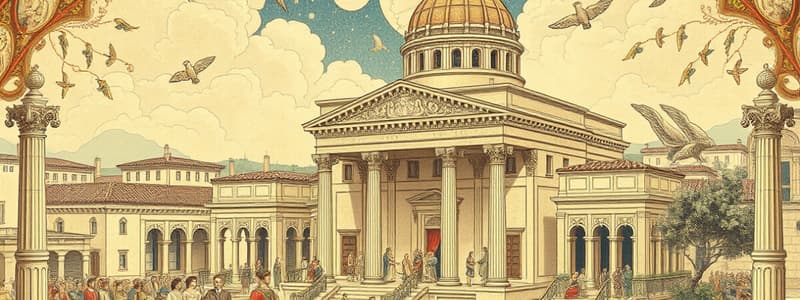Podcast
Questions and Answers
To what group did the wealthy upper class of Ancient Rome belong?
To what group did the wealthy upper class of Ancient Rome belong?
The Patricians.
Who were included in the plebeians?
Who were included in the plebeians?
Anyone not a patrician, the common people of Rome, farmers, craftsmen, laborers, and soldiers.
How did you become a patrician in Ancient Rome?
How did you become a patrician in Ancient Rome?
By being born into a patrician family.
What is the form of government called that Rome had?
What is the form of government called that Rome had?
A republic government is quite different from a democracy.
A republic government is quite different from a democracy.
The United States of America is a democracy not a republic.
The United States of America is a democracy not a republic.
What early laws protected the basic rights of all Roman citizens regardless of class?
What early laws protected the basic rights of all Roman citizens regardless of class?
In the latter stages of the Roman Empire, there were few legal differences between the plebeians and the patricians.
In the latter stages of the Roman Empire, there were few legal differences between the plebeians and the patricians.
How did the plebeians revolt against the patricians in early Rome?
How did the plebeians revolt against the patricians in early Rome?
What were the public officials elected by the plebeians called?
What were the public officials elected by the plebeians called?
Which of the groups below were the very lowest people in Rome?
Which of the groups below were the very lowest people in Rome?
Choose a perspective to analyze the Ancient Roman Government from - either plebeian or patrician.
Choose a perspective to analyze the Ancient Roman Government from - either plebeian or patrician.
Choose one answer from below that shows true facts only (no false facts)
Choose one answer from below that shows true facts only (no false facts)
Choose the one answer that is true about the rights of plebeians in early Rome.
Choose the one answer that is true about the rights of plebeians in early Rome.
Flashcards are hidden until you start studying
Study Notes
Social Structure of Ancient Rome
- Patricians: The wealthy upper class in Ancient Rome, holding significant political power.
- Plebeians: Common people including farmers, craftsmen, laborers, and soldiers; anyone not in the patrician class.
- Slaves: The very lowest social class in Rome, with no rights.
Government of Ancient Rome
- Republic: Rome's form of government, characterized by elected officials and a system of checks and balances; served as a model for future governments, including the United States.
- Active Citizenship: In a republic, citizens are expected to engage in governance, primarily through voting.
Rights and Citizenship
- Types of Citizens:
- Full Citizens: Born in Rome to patrician parents; could vote, marry freeborn individuals, and engage in commerce.
- Partial Citizens: Often conquered peoples; lacked voting rights and eligibility for public office but held some other privileges.
- Law of the Twelve Tables: Established early laws that protected the basic rights of all Roman citizens, irrespective of class.
Plebeian Rights and Actions
- Revolts: Plebeians protested against patrician dominance by leaving the city, refusing to work, and declining to fight in battles.
- Tribunes: Public officials elected by the plebeians to represent their interests in government.
- Marital Restrictions: Plebeians could not marry patricians, reflecting the social divide.
Evolution of Legal Status
- Final Stages of the Empire: By this time, legal differences between plebeians and patricians became minimal, indicating some social progress.
Personal Perspective
- Patrician Viewpoint: As a patrician, rights included voting, marrying freeborn individuals, practicing commerce, and running for office, highlighting the privileges enjoyed by the elite class in Rome.
Studying That Suits You
Use AI to generate personalized quizzes and flashcards to suit your learning preferences.




